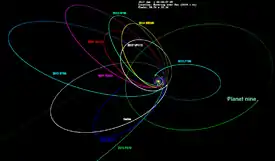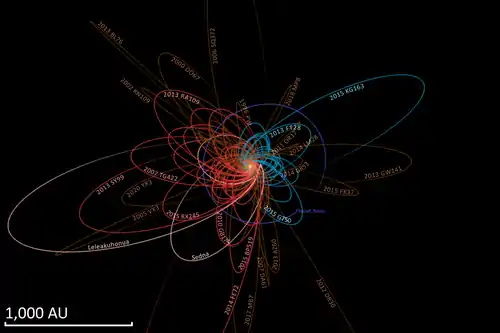2010 GB174
2010 GB174 is a detached object, discovered on 12 April 2010 at the Mauna Kea Observatory. It never gets closer than 48.5 AU from the Sun (about the outer edge of the Kuiper belt). Its large eccentricity strongly suggests that it was gravitationally scattered onto its current orbit. It is, like all detached objects, outside the current influence of Neptune, so how it got its current orbit is unknown. 2010 GB174 has the third highest Tisserand parameter relative to Jupiter of any Trans-Neptunian object, after Sedna and 2012 VP113. It has not been observed since 2012.[1] It comes to opposition 27 March 2016 in the constellation of Virgo.
 Orbits of 2010 GB174 (dark blue) and other scattered/detached objects, along with hypothetical Planet Nine on the right | |
| Discovery | |
|---|---|
| Discovery date | 12 April 2010 |
| Designations | |
Designation | 2010 GB174 |
| detached object | |
| Orbital characteristics [1] | |
| Epoch 13 January 2016 (JD 2457400.5) | |
| Observation arc | 2.64 years |
| Earliest precovery date | 26 June 2009 |
| Aphelion | |
| Perihelion | 48.7±0.3 AU |
| Eccentricity | 0.869±0.01 |
| 3.22°±0.4° | |
| Inclination | 21.54° |
| 130.6° (Ω) | |
| 347.8°±0.4° (ω) | |
| Physical characteristics | |
| Dimensions | |
| Albedo | 0.08 (assumed) [4] |
| 25.2 [6] | |
| 6.6 [1] | |
Precovery images have been found back to 26 June 2009.[1]
It reached perihelion (closest approach to the Sun) around 1952[1] and has moved beyond 70 AU in September 2014.[6] It is possibly a dwarf planet.[4]
Comparison

See also
- List of Solar System objects most distant from the Sun in 2015
- List of most distant trans-Neptunian objects
References
- "JPL Small-Body Database Browser: (2010 GB174)". Archived from the original on 26 June 2013. Retrieved 24 January 2016.
- Horizons output. "Barycentric Osculating Orbital Elements for 2010 GB174". Retrieved 23 January 2016. (Ephemeris Type:Elements and Center:@0)
- Malhotra, Renu; Volk, Kathryn; Wang, Xianyu (2016). "Corralling a distant planet with extreme resonant Kuiper belt objects". The Astrophysical Journal Letters. 824 (2): L22. arXiv:1603.02196. Bibcode:2016ApJ...824L..22M. doi:10.3847/2041-8205/824/2/L22. S2CID 118422279.
- Michael E. Brown. "How many dwarf planets are there in the outer solar system? (updates daily)". California Institute of Technology. Archived from the original on 18 October 2011. Retrieved 16 February 2014.
- "ABSOLUTE MAGNITUDE (H)". NASA/JPL. Retrieved 27 May 2013.
- "AstDyS 2010 GB174 Ephemerides". Department of Mathematics, University of Pisa, Italy. Retrieved 28 March 2014.
External links
- 2010 GB174 at AstDyS-2, Asteroids—Dynamic Site
- 2010 GB174 at the JPL Small-Body Database